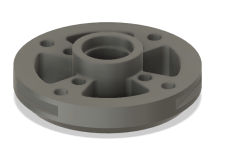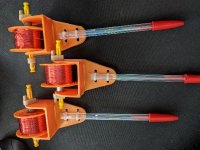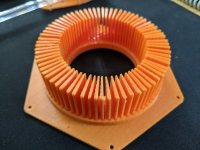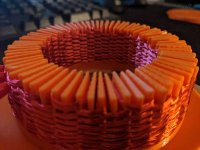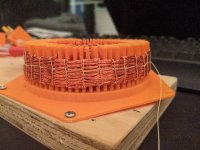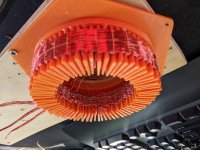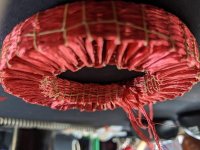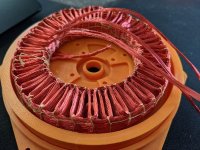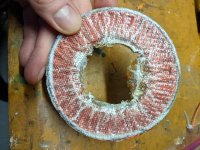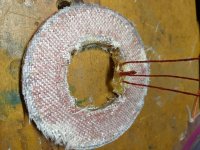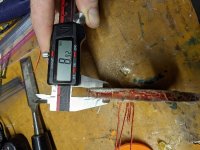Jrbe said:
How are you planning on attaching the stator to the hub?
It might be worth adding some consumable / mold in place features to help hold it together and key the stator to the hub. You could also print a mold in place stator frame and hub like you'd see in a washing machine motor then pot it if you want. You should be able to print with some high temp plastics so this is doable.
This is actually sort of what I attempted. I tried to make a part of the press that would create the negative space for some screws that would ultimately screw into some heat set inserts that I would put on the underside of the hub. Ultimately the inner diameter was going to just be epoxy. Then the hub itself would be a separate piece entirely. I could likely drill the holes for the screws after the fact if this is the way I end up proceeding.
Jrbe said:
How are you pressing the hub? You could look at using shoulder bolts or spacer collars evenly spaced inside and out so it's consistently clamped down at a specified distance vs fighting high and low spots with pressure / vacuum. Vacuum can help remove air pockets and can work magic with vacuum infusion to fill the resin. But it seems like there might be some thickness irregularities that you won't want to use high or any vacuum as it cures.
You could also add in some sprues to allow excess resin to escape, not spill, then cut / snap them off flat when it's set.
I'm sure the press that I have made could be improved quite a bit. Its essentially a plastic shell and I am using 4 clamps that each have a 300lb capacity If I recall correctly. I just clamp them down evenly around the top and bottom of the press. Shoulder bolts could certainly be helpful here. But the plastic shell essentially makes a spacer that limits it from being pressed thinner than 6.5mm. the irregularity in height was directly related to the epoxy curing too quickly.
Jrbe said:
Epoxy can definitely suffer from thermal runaway if is too thick. I'd imagine a potting resin would be more stable for you or maybe using a longer cure time resin.
This seems to be the consensus. Unfortunately I have not found another "high temperature" liquid epoxy with a longer cure time. So I may have to settle for a weaker epoxy.
Jrbe said:
Elmers glue can be watered down and used as a cheap PVA. PVA is a water washable mold release that can be really helpful if it's used properly.
I've not heard of this. I will look more into it. Thanks for the tip.
Jrbe said:
Is it worth practicing with a string wound stator (no copper, maybe woven nylon string about the size of your wire) to practice and work out the process bugs?
Yes. Absolutely. I am tired of wasting the copper and woven nylon might work well so I don't have to make the litz wire. easy peasy. great suggestion. sometimes I'm a glutton for punishment.
TorontoBuilder said:
I wonder if you may have better and more consistent results with a silicone mould so you dont have to use plastic liner as you are.
I've thought of making a silicone mold for parts of it, but 1. I have not done something like that before, so just another learning experience. 2. The plastic bags are really cheap and effective as long as its a flat surface.
I'm not opposed to silicone, but I don't think I'm quite there yet.
TorontoBuilder said:
Also, perhaps a less viscous and slower setting epoxy resin that you can add small glass fibers to. I've had very good results making close tolerance reinforced parts that way. Ditch the glass mats that way too
Do you think that the glass fibers would add more stiffness than the sheets? the sheets are easy to work with, and only add a negligible thickness with the 4 or so I have used. I like the Fiberglass tow idea too, I think that could be even easier to work with, and I wonder if it would allow me to ditch the sheets too. I may try a number of tests to see what works best.
APL said:
Keep up the good work, setbacks are how we learn.
Totally, and thanks for the suggestions. I agree, testing will be a quicker/cheaper path of iteration
Xer077 said:
Hello HH.. just registered to comment some amateur questions/ideas that may not be helpful.
I can't remember how I found this thread, but I've been coming back to see your progress over the last few months and it's really caught my imagination. I've gone from pen and paper to SketchUp and Blender, trying to work out what's in my head..
So, I was wondering about 3d printing as much of the machine as possible.. it seems that the highest quality metal printers are still out of reach for most of us, but there's at least one company selling pla filament with 90% copper content, which (they say) works with most printers. I think it then requires firing in a kiln, so printing with a dual filament printer and isolating the copper with more pla would be out of the question.. but they also have a similar filament with 90% ceramic powder content.
You can see where I'm going with this.. So, any obvious problems with this train of thought?
I too am subscribed to Integza on YouTube. if that's not what you were referring to, check him out. He's got some neat content.
I also started by 3D printing as much as I could and that will get you pretty far if you are willing to sacrifice, some size and performance. I think that conventionally manufactured parts are simply going to be more suited for the stresses of this type of machine. A professionally 3D printed motor might be more capable, but as you mentioned metal printing is still a bit out of reach for hobbyists.
I think that there is potential in making some parts using the metal filaments, but I think you will not achieve accurate or consistent tolerances due to how this material shrinks through the firing process. This is partly why I didn't venture down this path. But also, because there's a lot of prototyping that could be done with plastic prior to that, but honestly, I don't have any first hand experiencing working with such materials to really give a solid opinion. TorontoBuilder seems to have more knowledge than I do about this subject.
As far as ceramic goes, I have considered trying to work with that because it seems like a viable heat-sink that will not interact negatively with the magnetic field of the rotors, but it still has the same issues, and I worry it my be brittle
Please if this is something you wish to pursue I would encourage you to make a thread. I've had a lot of fun posting here, and I've learned a ton


